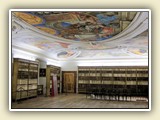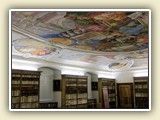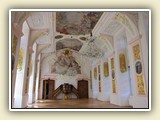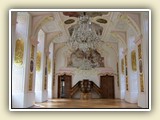On a hill above the Traun river in Upper Austria lies the
Benedictine monastery Lambach.
The founder of the monastery was Count Arnold II of Wels-Lambach. Around 1046 he had a secular canonical monastery built here. His son Adalbero went to Würzburg, studied there at the cathedral school and became bishop of Würzburg, as successor of the legendary Bruno. In 1056, he converted Lambach Monastery into a Benedictine monastery, sending Abbot Egbert and monks from the monastery of Münster-Schwarzach am Main.
The still preserved westwork of the first monastery church with its Romanesque wall paintings are witnesses of the founding period.
As early as 1089, monks from Lambach moved to Melk to found the monastery there.
During the Bavarian invasion in 1233 - Duke Otto II of Bavaria broke into the dominion of the Austrian Babenbergs - the monastery and the church were largely destroyed. The existing complex was built in the 17th and 18th centuries.
Through the main entrance you enter the monastery courtyard.
Click on the picture to look in the other direction!
The wonderful Romanesque frescoes in the Westwork are the oldest in the southern German-speaking area. They may not be photographed. This is a photo from a photo! They show stories from the Old and New Testament.
This baroque reading machine is located in the abbey library, which is equipped with 60'000 old volumes. For studies one could read up to four books at the same time.
More pictures of:
- the library
- the baroque summer refectory. This is the former dining hall of the monks, built by master builder Carlo Antonio Carlone in the first half of the 18th century and now used as a concert hall
- the baroque banqueting hall on the first floor, above the summer refectory.
Sandstone figures and funny dwarfs are placed in the romantic convention garden.
Chapel
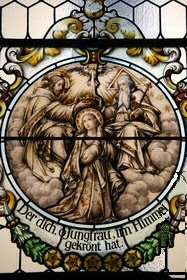
The simple cloister with beautiful glass windows connects the baroque monastery with the church.
A view into the baroque collegiate church, in which also the grave of St. Adalbero is located ...
... and to the organ of Christoph Egedacher
In Austria's only surviving baroque Stift Theatre also Marie Antoinette experienced a performance on her way to Paris.
Our guide and Vreni in the baroque theatre
Vreni in the pilgrim hostel of the monastery
From the terrace of the monastery you have a wonderful view of the Traunstein.
